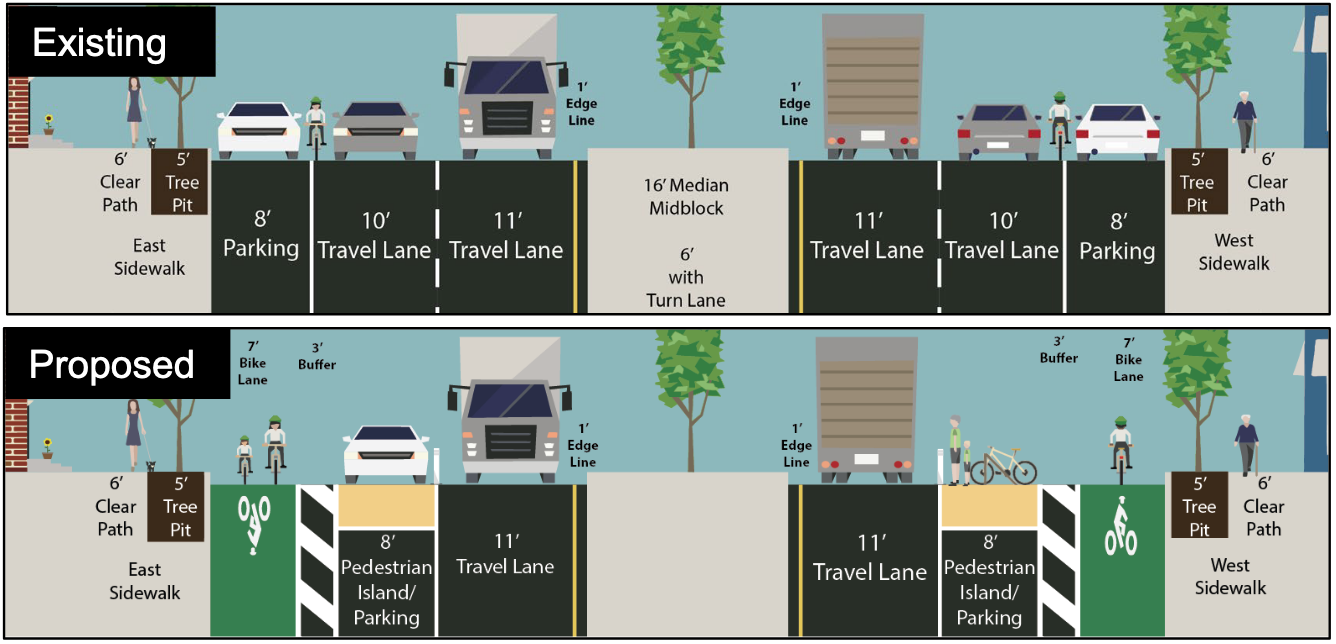What Does a Safe McGuinness Look Like?


After two years of advocacy from Greenpoint neighbors and elected officals, and after a thorough study by the DOT, the DOT has proposed a redesign of McGuinness Boulevard. The plan will:
- Add a protected bike lane in each direction to protect cyclists and make the street safer for all road users
- Remove one lane of traffic in each direction to slow traffic and accomodate the new bike lanes
- Add neighborhood loading zones to faciliate local deliveries
- Maintain the majority of existing street parking
We are supportive of these changes, and would like to see them implemented as soon as possible.
Where are we now?
After the mayor scuttled the full, comprehensive redesign proposed by the DOT, a pared down version was implemented in the summer of 2023. As of now (spring 2024), McGuinness still has two lanes of vehicle traffic in each direction, but the parking lanes north of Freeman have been replaced by bike lines. While we're happy to see those bike lines, we need to see them run the the length of the boulevard down to Meeker. And just as importantly, the second traffic lane in each direction needs to go. This will ensure a safer crossing for pedestrians, and discourage dangerous driving and cut through traffic.
You can read more about redesign's oppositions in publications such as Curbed and The City, as well as from our Instagram (here and here).
We need to show the Mayor's office that Greenpoint is firmly in support of a redesigned McGuinness, where residents, visitors, and workers can walk, bike and drive safely. Please sign the petition and follow our Instagram for further updates and calls to action. We can't do this without you!
FAQs
The McGuinness Boulevard redesign is carefully planned to improve traffic flow and safety without causing significant disruption to side streets. One of the common concerns when a road is redesigned is that traffic will be diverted to smaller side streets, but this is not necessarily the case.
Induced demand occurs when an expansion of road capacity leads to more people choosing to drive, which can often negate any improvements in traffic flow.
Conversely, when road capacity is reduced, as in the McGuinness Boulevard redesign, some of the traffic may simply evaporate. People adjust their behavior quickly: they may choose alternate routes, switch to walking, cycling or public transportation, change the times they travel, or simply not take that trip.
30% to 50% of the traffic on McGuinness is cut-through. By making McGuinness less attractive as a shortcut between the Long Island Expressway and the Brooklyn-Queens Expressway, the redesign is expected to largely reduce the overall volume of traffic through reduced demand and keeping traffic on the Expressways. Because the current advantage of McGuinness over the BQE and LIE is only about a minute, it will not be attractive for this traffic to divert to side streets.
In Manhattan, reducing motorised traffic on Broadway hasn't caused (more) congestion on parallel avenues. In Barcelona, interventions greatly decreased traffic on affected streets and in adjacent streets, with directly adjacent streets reporting a minimal increase in traffic (+0.7%). In 2001, researchers reviewing road interventions in multiple countries concluded that predictions of unbearable traffic as a result of reallocating space away from private vehicles were, in most cases, alarmist.
If, against predictions, the DOT's monitoring shows that spillover traffic on side streets occurs, it can be mitigated by traffic calming, turn restrictions, one-way reversals, etc.
- Vanderbilt Ave, BK: 100% increase
- 9th Ave, Manhattan: 49% increase
- Bronx Hub, Bronx: 50% increase
This is why 100+ businesses located on or near McGuinness Boulevard support the DOT's plans to make it safe.
Although there are some signs on McGuinness indicating it's an evacuation route, specific evacuation routes are no longer in use by NYC. Should an evacuation be necessary, residents will still be able to use the boulevard on foot, by vehicle, or by bicycle.
In Paris, new cycle paths have significantly reduced emergency vehicle response time.
- Community workshops on 8/4/2021, 9/29/2021, 11/18/2021 (with Polish translation)
- Community Board 1 Transportation Committee, 6/30/2022 (slides)
- Town Hall: 11/14/2022
- Street Ambassador outreach (249 intersections, 403 comments)
- Online feedback map (750+ comments)
- Merchant survey (46 businesses surveyed on McGuinness)
- Meetings with industrial businesses, theatrical businesses, safety advocates
- 9500+ neighbors (including you?) have signed the Petition in Support of a Safe McGuinness
- 100+ businesses on or near McGuinness Blvd
- Greenpoint state assemblyperson Emily Gallagher (District 50)
- Greenpoint state senator Kristen Gonzalez (District 59)
- Greenpoint state senator Julia Salazar (District 18)
- Greenpoint councilmember Lincoln Restler (District 33)
- Brooklyn Borough President Antonio Reynoso
- NYC Public Advocate Jumaane Williams
